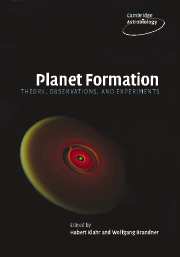Book contents
- Frontmatter
- Contents
- Preface
- Acknowledgments
- 1 Historical notes on planet formation
- 2 The Formation and Evolution of Planetary Systems: placing our Solar System in context
- 3 Destruction of protoplanetary disks by photoevaporation
- 4 Turbulence in protoplanetary accretion disks: driving mechanisms and role in planet formation
- 5 The origin of solids in the early Solar System
- 6 Experiments on planetesimal formation
- 7 Dust coagulation in protoplanetary disks
- 8 The accretion of giant planet cores
- 9 Planetary transits: a first direct vision of extrasolar planets
- 10 The core accretion–gas capture model for gas-giant planet formation
- 11 Properties of exoplanets: a Doppler study of 1330 stars
- 12 Giant-planet formation: theories meet observations
- 13 From hot Jupiters to hot Neptunes … and below
- 14 Disk–planet interaction and migration
- 15 The brown dwarf–planet relation
- 16 Exoplanet detection techniques – from astronomy to astrobiology
- 17 Overview and prospective in theory and observation of planet formation
- References
- Index
17 - Overview and prospective in theory and observation of planet formation
Published online by Cambridge University Press: 14 September 2009
- Frontmatter
- Contents
- Preface
- Acknowledgments
- 1 Historical notes on planet formation
- 2 The Formation and Evolution of Planetary Systems: placing our Solar System in context
- 3 Destruction of protoplanetary disks by photoevaporation
- 4 Turbulence in protoplanetary accretion disks: driving mechanisms and role in planet formation
- 5 The origin of solids in the early Solar System
- 6 Experiments on planetesimal formation
- 7 Dust coagulation in protoplanetary disks
- 8 The accretion of giant planet cores
- 9 Planetary transits: a first direct vision of extrasolar planets
- 10 The core accretion–gas capture model for gas-giant planet formation
- 11 Properties of exoplanets: a Doppler study of 1330 stars
- 12 Giant-planet formation: theories meet observations
- 13 From hot Jupiters to hot Neptunes … and below
- 14 Disk–planet interaction and migration
- 15 The brown dwarf–planet relation
- 16 Exoplanet detection techniques – from astronomy to astrobiology
- 17 Overview and prospective in theory and observation of planet formation
- References
- Index
Summary
This conference truly reflects a microcosm of an explosive revolution in the quest to understand the origin of planet and star formation. The diverse nature of this wide-open field necessitates a multi-facet attack on all relevant issues. In this pursuit, it is particularly important to find the missing links between the many seemingly independent observations as circumstantial clues around a global picture. The development of a comprehensive coherent interpretation requires an integrated approach to identify the dominant physical processes which determine the physical characteristics of planets and the dynamic architecture of planetary systems.
On the basic concept of planetary origin, there is very little difference between modern theories and the original Laplacian hypothesis. The coplanar geometry of all the major planets' orbits hardly needs any extrapolation for theorists to postulate the scenario that the planets formed long ago in a rotational flattened disk which is commonly referred to as the Solar Nebula. Today, we have direct images and multi-wavelength spectra of protostellar disks within which planet formation is thought to be an ongoing process. Perhaps the biggest advancement in the past decade is the discovery of over 100 planets around nearby stars other than the Sun. For the first time in this scientific endeavor, the Solar System reduces its unique importance to a single entry in the rapidly growing database of planetary-system census.
- Type
- Chapter
- Information
- Planet FormationTheory, Observations, and Experiments, pp. 256 - 262Publisher: Cambridge University PressPrint publication year: 2006
- 3
- Cited by



